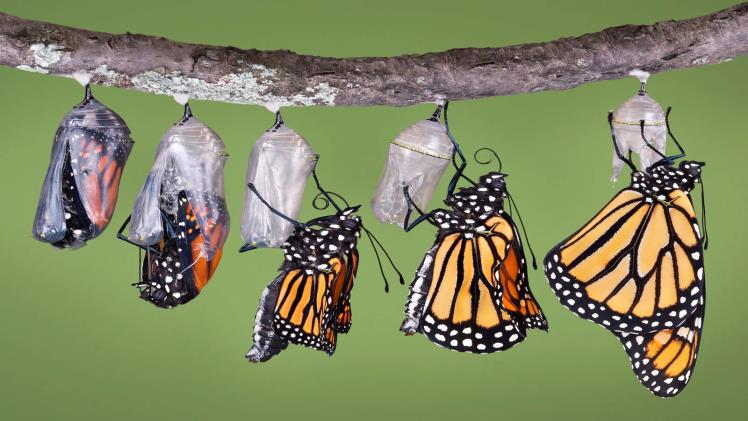The monarch butterfly (Danaus plexippus) is one of the most iconic and recognizable insects in North America, known not only for its striking orange-and-black wings but also for its remarkable migration and fascinating life cycle. This butterfly undergoes a complete metamorphosis, transitioning through four distinct stages: egg, larva (caterpillar), pupa (chrysalis), and adult. Understanding each stage of the monarch’s life reveals just how miraculous this transformation truly is.
Stage 1: Egg
Duration: 3–5 days
The monarch life cycle begins when a female butterfly lays her eggs on the underside of a milkweed leaf—the only plant monarch caterpillars eat. Each egg is tiny, about the size of a pinhead, and oval-shaped with a ridged texture.
Monarch females are highly selective about where they lay their eggs. They often test the plant with their feet to ensure it’s milkweed and a good food source for their future offspring. A single female may lay hundreds of eggs in her lifetime.
Stage 2: Larva (Caterpillar)
Duration: 10–14 days
Once the egg hatches, a small caterpillar (larva) emerges and begins eating the milkweed leaves immediately—including the eggshell it just emerged from. This stage is all about growth, and the caterpillar will increase its body mass up to 2,000 times!
The monarch caterpillar goes through five instars (growth phases), shedding its skin each time. It develops its characteristic black, white, and yellow stripes as it matures. Milkweed contains toxins (cardenolides) that make monarchs toxic to predators, and caterpillars absorb these toxins to protect themselves even in the larval stage.
Stage 3: Pupa (Chrysalis)
Duration: 8–15 days
After its final molt, the caterpillar finds a safe spot, usually the underside of a leaf or a hidden stem, and forms a silken pad from which it hangs in a J-shape. It then sheds its skin one last time to reveal a bright green chrysalis with golden specks.
Inside the chrysalis, a truly amazing transformation occurs. The caterpillar’s body breaks down, and adult features like wings, antennae, and legs form in a process called metamorphosis. Though it appears inactive on the outside, this is a period of intense development.
As the chrysalis nears the end of this stage, it becomes transparent, and you can start to see the butterfly’s wings inside.
Stage 4: Adult Butterfly
Duration: 2–6 weeks (or up to 8 months for migratory generation)
When the transformation is complete, the adult monarch emerges from the chrysalis. Its wings are soft, folded, and wet at first, so the butterfly pumps fluid into them and waits a few hours for them to dry and harden before it can fly.
Adult monarchs feed on nectar from flowers, using their long proboscis to sip the sugary liquid. They play a vital role in pollination and continue the life cycle by mating and laying eggs on milkweed plants.
There are typically four generations of monarchs each year, with the last generation known as the “migratory generation.” This special group undertakes an epic journey, traveling thousands of miles from the northern U.S. and Canada to overwintering sites in Mexico and coastal California.
Monarch Migration: A Marvel of Nature
The migration of the monarch butterfly is one of the most extraordinary phenomena in the insect world. Unlike most butterflies that live only a few weeks, the monarchs that migrate can live up to 8 months. They use environmental cues like sunlight and temperature to guide them to their overwintering grounds—often in forests they’ve never seen before.
This migratory generation does not reproduce until the following spring when they begin the journey north again and lay eggs, starting the life cycle all over.
Conservation Concerns
Despite their beauty and resilience, monarch populations are declining due to habitat loss, climate change, and pesticide use. The destruction of milkweed plants—crucial for egg-laying and caterpillar survival—has been a major factor.
To help monarch butterflies, individuals can:
- Plant native milkweed and nectar-rich flowers
- Avoid using pesticides and herbicides
- Support conservation efforts and citizen science projects like Monarch Watch
Final Thoughts
The life cycle of a monarch butterfly is a powerful example of nature’s complexity and beauty. From tiny eggs to bold-winged migrants crossing continents, each stage tells a story of survival, transformation, and resilience. Understanding this cycle not only enriches our appreciation of these incredible insects but also reminds us of the importance of protecting their habitats for future generations to marvel at.
FAQ: The Life Cycle of a Monarch Butterfly
Q1: What are the four stages of a monarch butterfly’s life cycle?
A: The monarch butterfly undergoes complete metamorphosis, consisting of four stages:
- Egg
- Larva (Caterpillar)
- Pupa (Chrysalis)
- Adult Butterfly
Q2: How long does it take for a monarch to complete its life cycle?
A: The full life cycle takes about 4 to 5 weeks on average, though the final generation of the year—responsible for migration—can live up to 8 months.
Q3: What do monarch caterpillars eat?
A: Monarch caterpillars feed exclusively on milkweed. This plant provides essential nutrients and contains toxins that make the caterpillars and adult butterflies unpalatable to predators.
Q4: Why is milkweed important for monarchs?
A: Milkweed is crucial because it is the only plant monarch butterflies lay their eggs on and the sole food source for their larvae.
Q5: How can you tell when a caterpillar is about to pupate?
A: The caterpillar will stop eating, find a safe, hidden place, and hang in a J-shape before shedding its skin to form a chrysalis.
Q6: What happens inside the chrysalis?
A: Inside the chrysalis, the caterpillar undergoes metamorphosis. Its body breaks down and reorganizes into an adult butterfly with wings, antennae, and new internal organs.
Q7: How do monarchs contribute to the environment?
A: Adult monarchs help pollinate flowers as they feed on nectar, supporting plant reproduction and ecosystem health.
Q8: Why is the final generation of monarchs special?
A: The fourth generation, often called the migratory generation, flies thousands of miles to overwintering sites in Mexico or California. They live much longer than the earlier generations and begin the life cycle anew in spring.
Q9: What threats are monarch butterflies facing today?
A: Monarchs face challenges like habitat loss, pesticide use, climate change, and the decline of native milkweed populations.
Q10: How can I help protect monarch butterflies?
A: You can:
- Plant native milkweed and nectar-rich flowers
- Avoid pesticides and herbicides
- Participate in programs like Monarch Watch
- Educate others about monarch conservation






